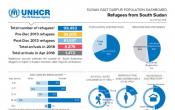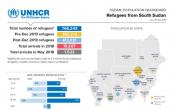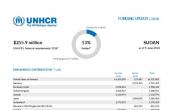Sudan
Operation: Sudan
Location
{"longitude":30,"latitude":14,"zoom_level":5,"iso_codes":"'SDN'"}
By clicking on the icons on the map, additional information is displayed.
Key Figures
| 2017 year-end results | |
| 195,600 | newly arrived South Sudanese refugees were assisted with life-saving and basic services |
| 77,000 | refugee children were enrolled in primary education |
| 1,800 | individuals at risk of statelessness especially in the eastern states and Khartoum were provided legal aid, representation and advice |
| 85% | of refugees had access to primary health care |
| 52% | of the South Sudanese refugee population lived in satisfactory conditions of sanitation and hygiene |
| 2018 planning figures | |
| 100% | of people of concern for whom data disaggregated by sex, age, location and diversity is available |
| 90% | of primary school-aged refugee and asylum-seeking children will be enrolled in primary education |
| 80% | of households whose needs for basic and domestic items will be met |
| 75% | of households will be living in adequate dwellings |
| 50% | of people of concern (18-59) earning at least minimum wages for more than 6 months per year |
Latest Updates and Related Links
People of Concern
28%
Decrease in
2016
2016
| 2016 | 2,704,048 |
| 2015 | 3,735,966 |
| 2014 | 2,498,776 |

[["Refugees",421466],["Asylum-seekers",16052],["IDPs",2225557],["Returned refugees",37215],["Others of concern",3758]]
Loading ...
Sudan
< Back
2017
{"categories":[2013,2014,2015,2016,2017,2018],"budget":[116.72969403,160.308285897,171.322796876,167.165516029,202.257032266,255.89879875],"expenditure":[50.57392511,68.4190138,70.93360276,80.04125617,90.06267898,null]}
{"categories":[2013,2014,2015,2016,2017,2018],"p1":[70.71228347,115.474342387,137.778614176,135.018613209,167.478835536,218.35645491],"p2":[3.80925251,3.36070081,3.0773447,1.54826576,2.4839356,2.03309319],"p3":[null,null,null,null,6.313447,11.8467486],"p4":[42.20815805,41.4732427,30.466838,30.59863706,25.98081413,23.66250205]}
{"categories":[2013,2014,2015,2016,2017,2018],"p1":[30.00781492,45.14173249,57.11940336,70.44091682,83.95294052,null],"p2":[1.73839136,1.80628898,0.56779169,0.83128585,0.98464263,null],"p3":[null,null,null,null,null,null],"p4":[18.82771883,21.47099233,13.24640771,8.7690535,5.12509583,null]}
Loading ...
CHOOSE A YEAR
- 2014
- 2015
- 2016
- 2017
- 2018
Operational context
The operational environment in Sudan remained challenging in 2017, and was further compounded by the difficult economic situation in the country. The easing of economic sanctions in 2017 did not yield the expected positive impact on the local economy. The continuing devaluation of the local currency resulting in soaring prices of basic commodities as well as sporadic shortages of fuel heavily affected the most vulnerable within refugee and local communities.Continuing conflict and political instability in South Sudan causing an uninterrupted influx of refugees to Sudan coupled with inadequate funding negatively affected UNHCR’s ability to provide services. Durable solutions for all people of concern in Sudan remained limited. Despite these constraints, UNHCR achieved substantial results and contributed to the improvement of the lives of people of concern.
Sudan remained a source, transit and destination country for irregular movements, including for asylum-seekers and refugees using the eastern African migratory route to North Africa and further to Europe.
Population trends
In 2017, there were over 3.3 million people of concern in Sudan: close to 2 million IDPs, some 390,000 IDP returnees, as well as some 925,000 refugees and asylum-seekers. Of the 907,000 refugees, a majority of 773,000 were from South Sudan. Eritrean refugees constituted the second largest community, with over 108,000 in 2017. The Chadian refugee population of some 8,500 was reduced by 10 per cent as a result of the voluntary repatriation which began in December 2017 and will continue into 2018. UNHCR assisted some 940 Chadians refugees to return to Chad, and assisted in the reintegration of some 1,490 Sudanese refugees who returned from the Central African Republic.Key achievements
As 65 per cent of South Sudanese refugees resided outside of camps, UNHCR implemented host community support projects in White Nile and East Darfur to maintain peaceful coexistence and ease pressure on existing host community facilities.In East Sudan, more than 1,900 people of concern with trafficking and other protection-related issues received free legal assistance through legal representations, and some 50 survivors of sexual and gender-based violence (SGBV) received multi-sectoral assistance.
The voluntary repatriation of Chadian refugees from Darfur started in December 2017, when some 940 refugees were assisted to return to Chad. The remaining 4,000 who expressed interest to return to Chad will be assisted in 2018.
UNHCR assisted the reintegration of more than 1,940 Sudanese who voluntarily returned from the Central African Republic, due to the deteriorating situation.
Unmet needs
Inadequate funding and high inflation resulted in gaps in service provision:- adequate number of additional classrooms to accommodate all students could not be constructed, resulting in high numbers of out-of-school children;
- the required number of latrines in the camps could not have been constructed, resulting in a high population to latrine ratio;
- durable shelters could not be constructed thus people of concern were forced to live in emergency shelters which do not provide adequate protection;
- investment in infrastructure development, such as roads, was not possible, thus leaving most camps inaccessible during the rainy season;
- health facilities could not be improved in the White Nile state, leading to inadequate provision of health services;
- investment in host communities in South and West Kordofan states, in South Darfur state and other areas could not be made, causing potential tensions between refugee and host communities.
Working environment
The operational environment in Sudan remains challenging. Sudan is a source, transit and destination country for asylum-seekers, refugees and migrants travelling along the eastern African migratory route to North Africa and thereafter to Europe. Ongoing internal conflict in the peripheral regions of the country remains of significant concern. The continued economic deterioration in Sudan also negatively impacts the already vulnerable refugee population, which has limited access to formal employment. In addition to the large South Sudanese refugee population already in the country, the renewed conflict in Juba in July 2016 also triggered further refugee flows to Sudan.The Government of Sudan has an “open door” policy for asylum-seekers, providing land for the establishment of refugee camps and allowing refugees to access host community services such as education, health and water facilities. In addition, the Government has allocated land for the establishment of reception centres for new arrivals in the East, as well as in White Nile and Darfur.
Key priorities
Life-saving protection and assistance services which will be strengthened and prioritized in 2017 include:• improved access, reception, registration and documentation;
• camp management and coordination; and
• basic services including shelter, health, nutrition, water and sanitation, and primary education.
In addition, UNHCR will work to consolidate gains made in 2016 in terms of key strategic objectives, including continuation of the “Strategy to Address Human Trafficking, Kidnappings and Smuggling of Persons in Sudan – Strengthening Alternatives to Onward Movements (2015-17)” jointly developed by UNHCR Sudan, IOM, UNODC, UNICEF and UNFPA and the renewed self-reliance programme that aims at enhanced economic self-reliance, reduction of aid dependency and promotion of sustainable co-existence between the refugees and host communities
In the event of a funding shortfall, the ability of the Office to maintain existing services and assistance for people of concern will be impacted. Maintenance and rehabilitation of facilities and sanitation and waste management services in the refugee camps will be significantly affected. Inadequate funding will have dire consequences on the overall protection and well-being of refugees both in camps and in the ‘open areas’ as well as that of IDPs. Funding shortfalls may also result in refugees relying on negative coping strategies, including irregular onward movements to Europe in search of better opportunities.



